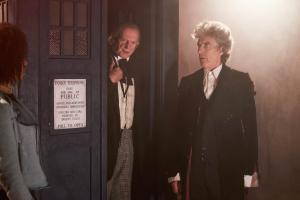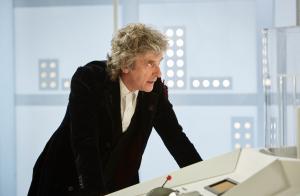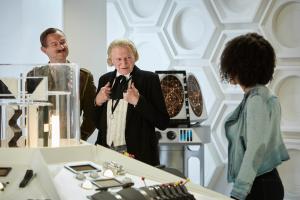 BBC One (United Kingdom):
BBC One (United Kingdom):
First Broadcast: Monday 25th December 2017
Nowadays, Doctor Who is a blessed show – whereas thirty years ago, it seemed cursed. After the sacking of a Time Lord the previous year, 1987 saw the show scheduled against a long-running and extremely popular soap opera, while starring a spoon-playing comedy actor who spoke out of his ‘R’s, accompanied by pantomime star Bonnie Langford and children’s television presenter Sophie Aldred.
When it returned in 2005 after a long hiatus, the show had evolved, instead of becoming a popular cult success through continued mass appeal. A declaration of love for the Time Lord quickly became a way into a quirky social scene celebration: geek chic rocks. However, fashion – sadly – is fickle. But the makers of the long-running sci-fi show are well aware of this – so they intentionally reboot the show every few years to ensure they buck the trend of being left behind or dated. Doctor Who is therefore unlike most science fiction franchises; braver than the ever-popular duet of Stars Trek and Wars, it never stays the same show long.
But changing all the time is a risky business. Some eras of the so-called “classic” years are held up as “pure” Doctor Who, while others are seen as the show losing its way, being thought of as either too silly or too violent. So when Peter Capaldi was cast as the Twelfth Doctor in 2013, a cheer was felt across the fan-base as the show looked like it was returning to roots with an older lead. (Although both David Tennant and Matt Smith gave excellent performances, their appeal was their youthful energy – so Capaldi could be seen as a bit of a risk to the non-fan.)
Four years down the line, Twice Upon A Time saw Capaldi’s time as the Doctor come to an end, as well as introducing Jodie Whittaker as – another risk, but this time for fan and non-fan alike – the first female incarnation of the time lord (shock horror!). But before that, there was time enough for one more risk for Capaldi: this time, there’s no evil plan. Instead, similar to Tennant’s or Smith’s departure indulgences, we have the Doctor meet himself to debate whether its time to move on.
Following on from the fan-serving cliffhanger of the Twelfth Doctor encountering his first incarnation, the episode follows the unexpected duo as they quarrel and philosophise about what both the past and future has in store for themselves in a way only Doctor Who can.
Unfortunately, although some great humour is found as the more current Doctor finds his early persona less than PC – we all look back and cringe at ourselves in the past, the doctor being no exception – the story itself lacks a hook. We know our modern Doctor is leaving, and the Earth isn’t threatened, so there’s no real concern to the outcome. Even the effect of the Doctor’s emotional reunion with previous companions was severely lacking when it is revealed that they are just memories, rather than the “real thing”.
Also, the First Doctor’s desire not to regenerate comes out of nowhere. Just before his final moments, William Hartnell’s original First Doctor dramatically declared “it’s far from being over!” and walked out into the heavy Antarctic snow, determined to reach his ship; that’s an example of powerful acceptance rather than refusal. Bradley’s softer recreation of this scene doesn’t entirely change the meaning. So was hearing the Twelfth Doctor shouting ‘Nooo!’ to the polar skies what changed his mind?

Throughout the episode, Peter Capaldi gives a superb final performance, as does David Bradley as the First Doctor, although he’s more a homage than a full-on virtual Hartnell. Show writer and occasional actor Mark Gatiss, meanwhile, gives a wonderful final turn as a confused and charming War World One soldier out of time in more ways than one.
Being both experimental while at the at the same time oddly similar to his previous episodes, Twice Upon A Time was also the last episode ever to be written by current showrunner Steven Moffat, who has helmed the show since 2010, and written episodes since 2005, and will be stepping down to be replaced by Broadchurch creator Chris Chibnall. So it was no surprise that the episode featured a few nods to the Moffat era, including an obligatory Dalek cameo and the usual mix of knowing meta moments, both funny and fan servicing.
On a technical level, the various worlds and past Earth settings are fantastically realised, as was the all-too-brief recreation of scenes from the First Doctor’s final adventure from 1966. With such effort into detail, I was thinking (indeed, hoping) for a “Back To The Future” approach to the old meeting new – but sadly, for most of the episode, only the two differing TARDIS console rooms show the contrast in the show’s development.
As a coda for the explosive previous season’s two-part finale, it works perfectly well: the third and final part of Capaldi’s farewell. The look, the laughs and occasional dab of poignancy of the episode made up for the narrative lulls. What plot there was – people being alive when they should really be dead – made the episode focus on the parallels being the Time Lord regeneration process, and bringing new life from death. Which was very appropriate, because as with Matt Smith before him, Jodie Whittaker’s fun and surprising entrance, though shorter than previous others, is a clear declaration of a new era in the show: the youthful energy is back.

Only the Twelfth Doctor’s actual final moments aboard the TARDIS – though exquisitely performed by Capaldi – felt completely indulgent, being more a chance for the Twelfth Doctor to go out speeching than saving a friend, a planet or the universe. Previously, we’ve seen this Doctor emote deeply against war; we’ve seen him plead for help to two versions of his best frenemy, and we’ve seen the heartbreak of him losing the memory of his closest friend. Wouldn’t it be better if we saw him leave as he arrived – cross and ranty?
But let’s be fair. As a piece of drama put on as Yuletide seasonal entertainment, it’s very strong. Though not that representative of the Moffat style or even the Capaldi arc, Twice Upon A Time gives a mature wave goodbye to the pure rebel Time Lord realising his war was over and to step aside and let new blood continue the fight. Yes, it is lacking any real sense of peril or threat, but instead, it is witty, moving and at times very sad. Anyone dealing with a family loss at this time of the year might wish it had been more a traditional festive romp with killer Christmas trees or robot santas.
But then, that’s the nature of risk – you end up with something you hadn’t had before, and change is good. So here it is: Doctor Who at Christmas. Look to the future – it’s only just begun.







